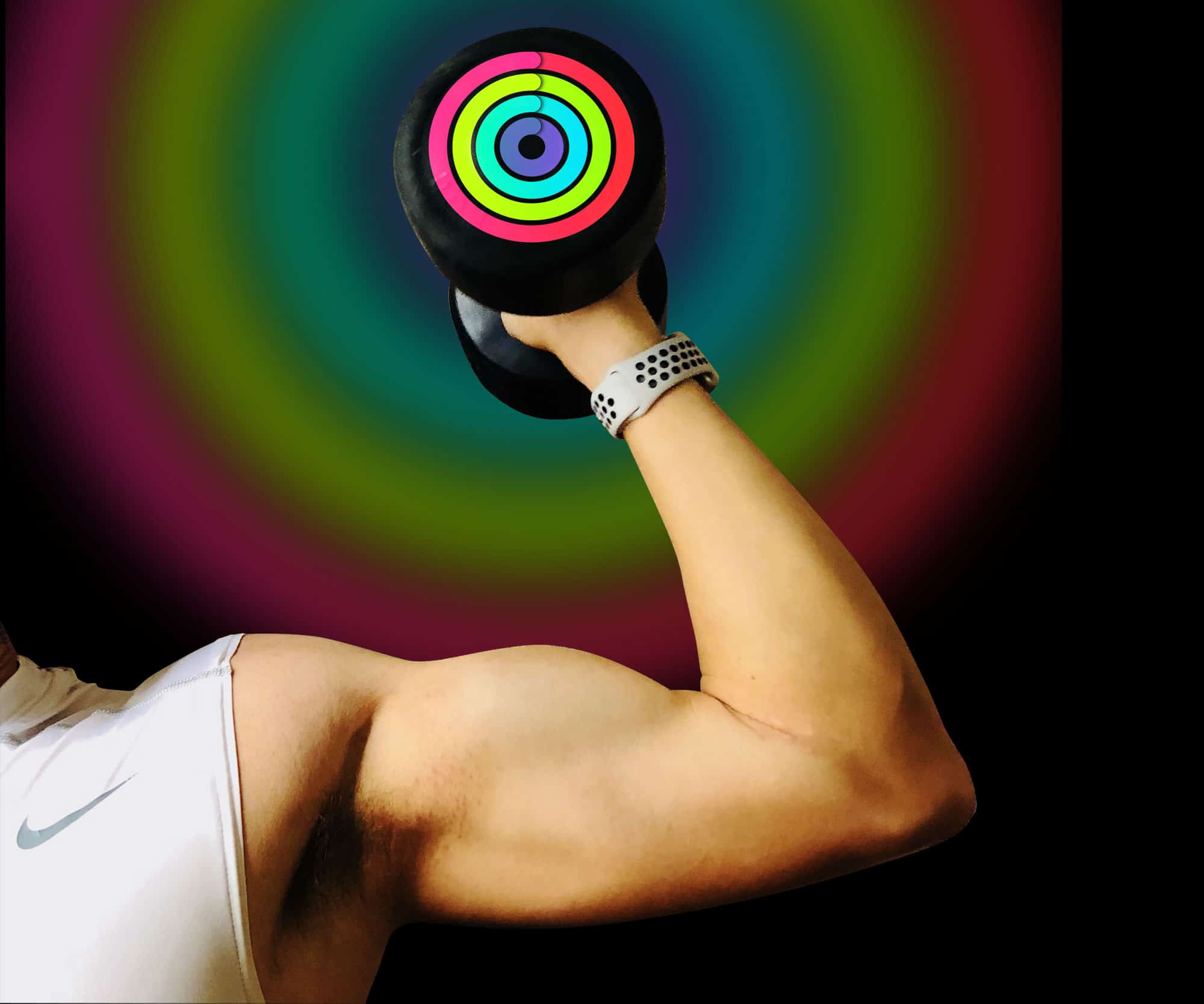The Activity Rings on your Apple Watch don’t provide a complete picture of your fitness. There is one important ring missing: Strength. The Rock didn’t get ripped just by standing up once an hour. And both the Exercise and Move rings essentially measure the same thing: cardio.
As any fitness expert will tell you, an effective workout program should combine cardio with strength training. Here’s why strength is currently Apple Watch’s weakness, and how you can use third-party apps to make sure it isn’t yours as well.
Why doesn’t the Activity app track strength training?
Imagine you walk a hundred yards from the supermarket to your car in the parking lot. Now imagine that same walk, but this time you are pushing a heavy shopping cart. That’s a lot more work, right? In both cases you’ve moved the same distance, but the latter is more strenuous because the weight of the cart creates resistance you must work against.
But to your Apple Watch, both walks look pretty much the same. The trouble is, it’s physically impossible for a wearable on your wrist to detect the resistance you are pushing or pulling with your hands. And that’s what strength training is all about.
Apple uses two things to calculate your activity rings: movement and heart rate. Whether you are pushing the cart or not, your movement is the same. Your heart rate will be somewhat elevated because of the extra work of pushing the cart, but that metric does not reveal the whole picture.
The problem is that with intense strength training, your muscles work primarily anaerobically. This means they work without relying on oxygen pumped from the lungs by your heart. Instead, they draw on energy reserves stored in your muscles. That means most of your strength training is completely invisible to your Apple Watch.
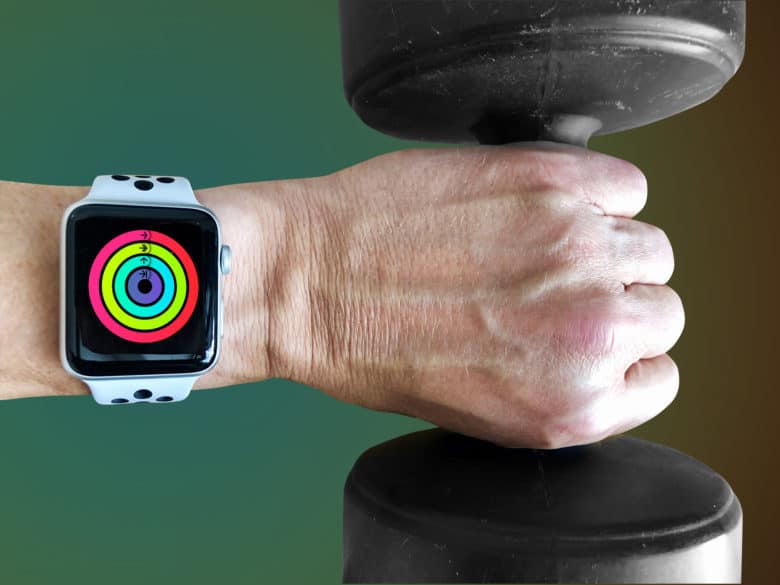 Apple Watch can’t detect weights you are holding in your hand.
Apple Watch can’t detect weights you are holding in your hand.
‘I go running and cycling with my Apple Watch. Isn’t that enough?’
A lot of people mistakenly believe that if they do a lot of running or cycling, there is no need for them to do strength training for their legs because they “already have that area covered.” But this is just not true. Why? Because our muscles are comprised of different types of fibers that respond to different kinds of training.
Fast twitch and slow twitch muscle fibers
There are two main categories of muscle fiber: type I, known as “slow twitch,” and type II, known as “fast twitch.” You use both kinds of fiber when you exercise, but endurance training (like running and cycling) focuses more on type I, whereas strength training focuses more on type II.
Slow twitch fibers are optimized for low-intensity exercise, like going for a long, slow jog, because they use energy generated from the oxygen delivered from lungs via your circulation. But if you increase the intensity of your workout, they can no longer keep up — oxygen alone is not enough.
That’s when fast twitch fibers kick in. These fibers rely on short-term energy stores in your muscle (in the form of glycogen), which enable them to deliver bursts of power required for lifting weights or sprinting. But this kind of activity quickly depletes the muscle’s glycogen store. It can’t be sustained for very long.
Fast twitch muscle fibers are bulkier than slow twitch, which is one of the reasons why athletes who focus on strength, like weightlifters and football players, tend to have bigger muscles than endurance athletes like marathon runners and soccer players.
Since these two types of muscle fiber perform such different functions, it is only natural that they require different kinds of training. You train your slow twitch fibers with “endurance” exercise like running and cycling. This is what Apple Watch focuses on. You train your fast twitch fibers with strength training, which usually involves lifting weights at the gym.
Strength training means more than good looks
Building strong muscles is not just about looking awesome, although obviously The Rock does look totally badass. There are many other benefits to strength training, some of which are a big help in everyday life.
For example, one of the benefits I noticed personally when I started strength training was that I could stand up from a chair without having to push up with my hands. I realized that was something I had not been able to do in years.
I know that might seem like a minor thing. But it’s one example of the type of thing you notice when you start strength training. It all makes life much easier and nicer.
There are also many health benefits to maintaining strong muscles. It reduces the risk of various diseases, and it provides a boost to your self-esteem and psychological well-being.
How strength training works (and how training apps can help)
The basic principle of strength training is known as “progressive overload.” This means lifting, pushing or pulling weights that take your muscles to the limit of what they can safely handle. In other words, weights that overload your muscles.
Over time, your muscles adapt to lifting these weights and can take heavier loads (or more “resistance”). So it is important to progressively increase the weights you are using to keep overloading your muscle and thus force them to keep adapting by getting stronger.
The built-in Workout app on your Apple Watch does not offer any progressive overload weight-resistance programs. Fortunately, plenty of third-party apps do. As a subcategory of fitness apps, people usually refer to them simply as “training apps.”
Choosing the right training app for you
Most training apps don’t focus exclusively on strength. They usually let you specify a training goal, or provide a variety of programs to choose from. If you’re already running, cycling or swimming with your Apple Watch, then you have the endurance/cardio side of your training covered already. So you should pick a program that focuses on strength.
Some of these apps rely exclusively on body weight exercises. This literally means using the weight of your own body as resistance — for example, by doing push-ups. Body weight apps are ideal for beginners because you don’t need a gym membership or much special equipment. The trouble is, after a while, to maintain progressive overload you will probably need something heavier than your own body to lift. That’s why to use some of these apps, you will need a gym membership or additional gear so you can use use heavier weights like dumbbells and barbells.
Here, I’ve picked out five of the best training apps on the App Store. All of them offer iPhone apps. Some also include Apple Watch and Apple TV apps. They all have their own strengths and weaknesses. Check out the mini reviews below, download an app, and start pumping iron!
1. Nike Training Club
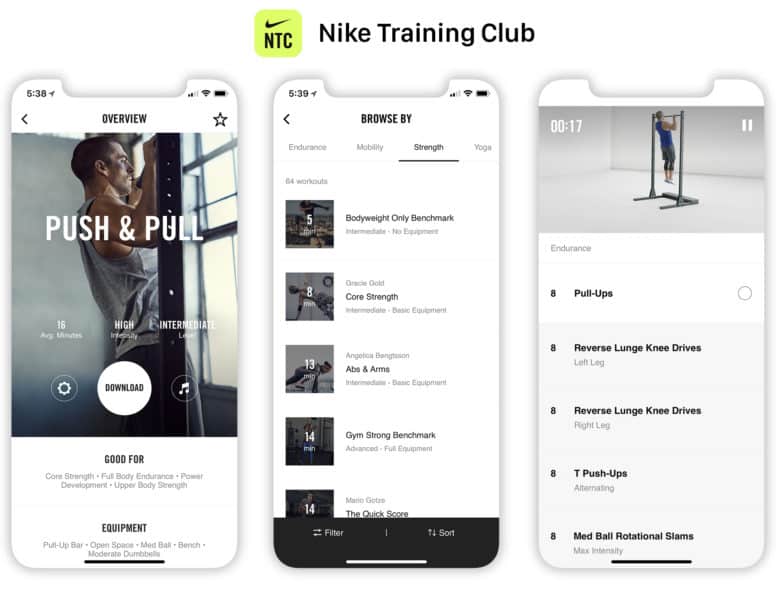
Nike Training Club (NTC) will feel familiar if you already use Nike Run Club. The two apps share the same design style and layout. Like it’s sibling, NTC is also free. Given that most training apps charge more than $10 a month, that’s pretty generous of Nike.
Training Club may be free, but Nike has not cut any corners here. The content is excellent, with great demo videos, a wide variety of workouts to choose from, and a well-thought-out, intuitive user interface. If you tap on Browse by Workout Type, you can select Strength and find more than 60 workouts to choose from. They include some workouts you can do at home without any equipment. For others, you will use dumbbells and barbells at the gym.
NTC includes HealthKit integration, so you can save your workouts to the Health app. But disappointingly, NTC currently offers no companion Apple Watch app. That means you cannot save your NTC workouts to Apple’s Activity app. I also found it a little fiddly when using AirPlay to view the NTC app’s workouts on a TV screen. It would be great to see a dedicated Apple TV companion app.
These minor gripes aside, though, NTC is a solid app. Given that it’s free, for most users it’s the obvious choice.
2. Keelo
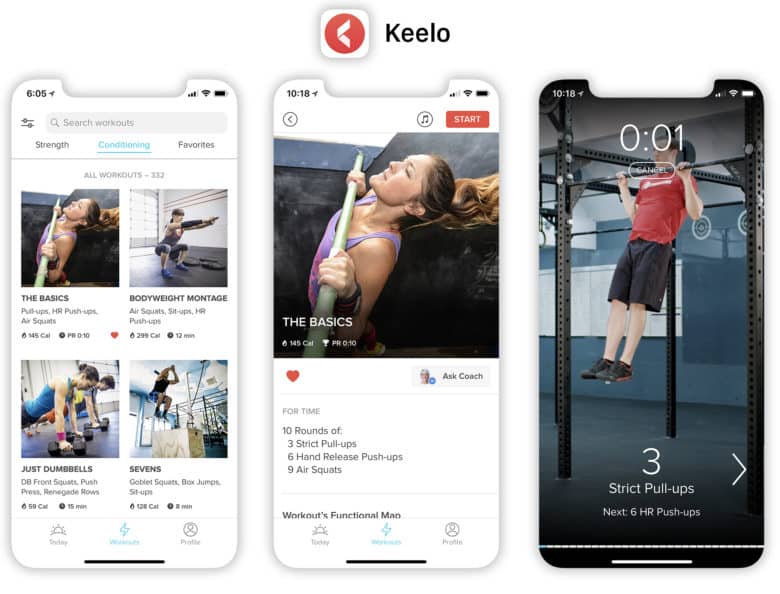
Keelo is a very polished and comprehensive training app that integrates HealthKit, Apple Watch and the Activity app. Its clear user interface provides large videos during your workout, showing you how to do the exercises. There are 16 workouts you can try for free, although these are “conditioning” workouts (which essentially means cardio).
You can use the two-week free trial to access all 300 workouts, including the strength ones. After those two weeks, a premium subscription will cost you $11.99 a month or $29.99 for three. This also gives you a personalized workout program based on an algorithm.
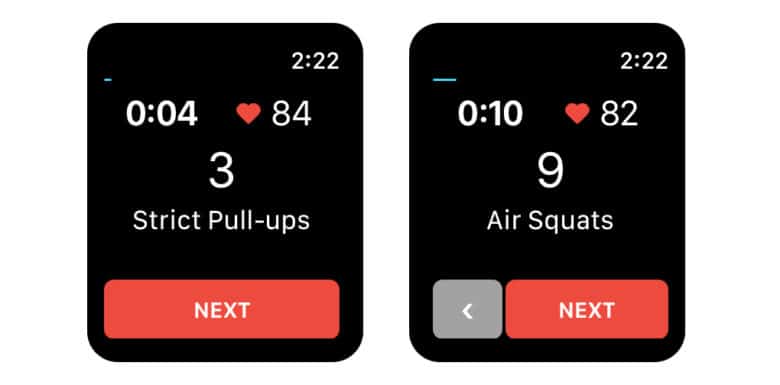
The Keelo Apple Watch app is a nice bonus. It’s fully integrated with the Activity app, so it can contribute to your rings. The only drawback I found was that it does not currently show the demo videos — for those, you must use your iPhone.
All Keelo workouts combine strength training with cardio, which will appeal to anyone who likes a HIIT approach to their workouts. Keelo’s founder, Hoon Kim, agues that HIIT achieves better results than traditional strength training because it engages your central nervous system more.
3. Freeletics Bodyweight & Gym
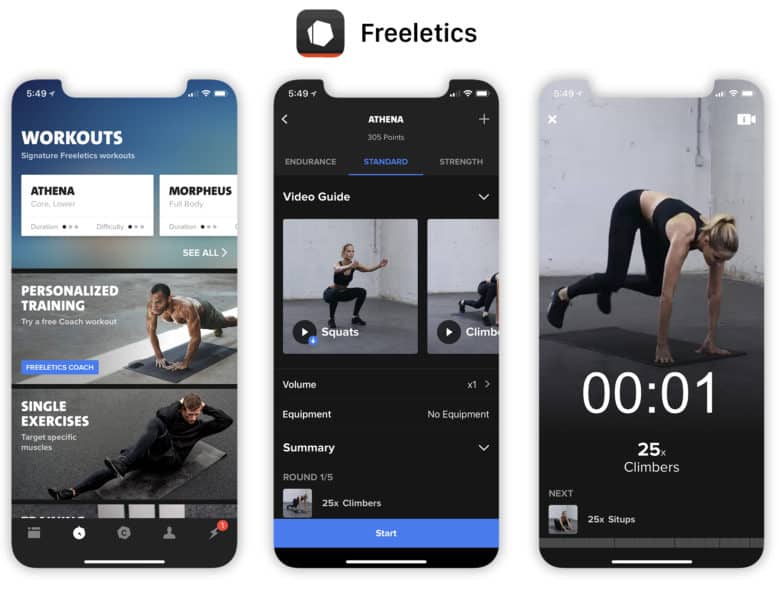 Freeletics offers two apps, one for bodyweight exercises and the other for free weights.
Freeletics offers two apps, one for bodyweight exercises and the other for free weights.
Freeletics offers two training apps rather than one. The first is called Bodyweight and it focuses on exercises you can do at home without any equipment. This is a good option for beginners. The user interface is well-designed. Excellent full-screen videos show you how to do the exercises during your workout.
The second app, called Gym, is suitable for those ready to lift heavier weights, like barbells and dumbbells. The trouble is, the Freeletics Gym app is not as good as the Bodyweight app. The user interface is much more basic and it does not save your workouts in the Health app via HealthKit.
Subscriptions cost $34.99 for three months. That gives you access to 37 workouts in the Bodyweight app and 29 in the Gym app. That’s less than what Nike offers for free, but Freeletics also provides a “coach” feature that uses an algorithm to generate tailored workouts just for you.
You don’t get a companion Apple Watch app with either Freeletics app, so your workouts are not saved to the Activity app, nor do they contribute to closing your rings.
4. Runtastic Results
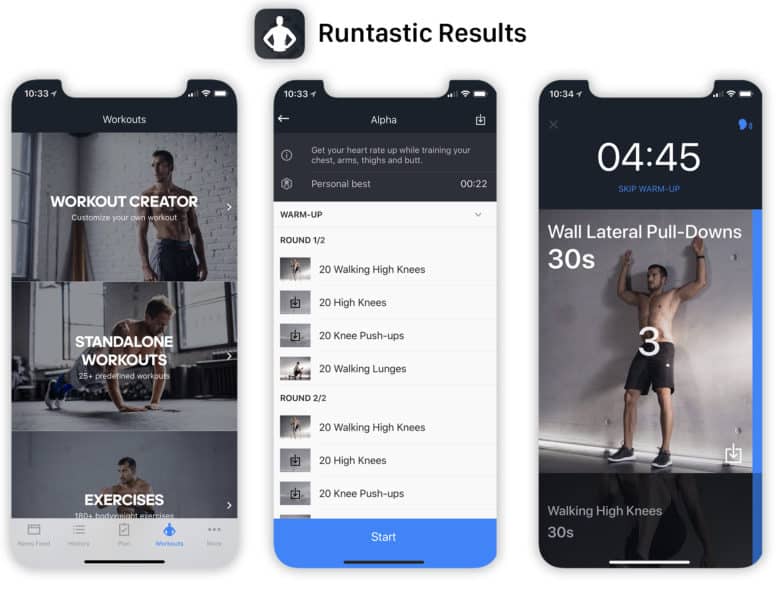
Runtastic Results comes from the makers of Adidas’ running app, Runtastic (obviously). It focuses exclusively on bodyweight exercises. That’s great if you want to work out at home, because you won’t need special equipment, but it does limit the app’s longevity. At some point, when you’re ready to lift heavier weights, you’ll want to switch to another app. So think carefully before taking out the a six-month subscription to Runtastic Results.
The design of the app and the how-to videos are excellent. The models are seriously ripped shirtless fitness models, which may be inspiring or off-putting, depending on your point of view.
A one-month subscription costs $9.99. The app supports HealthKit for saving your workouts to the Health app. And there’s even a version of the app for Apple TV, which is ideal if you have space to work out in your living room. However, since tvOS does not currently support HealthKit, you can’t save your workouts that way.
5. Aaptiv
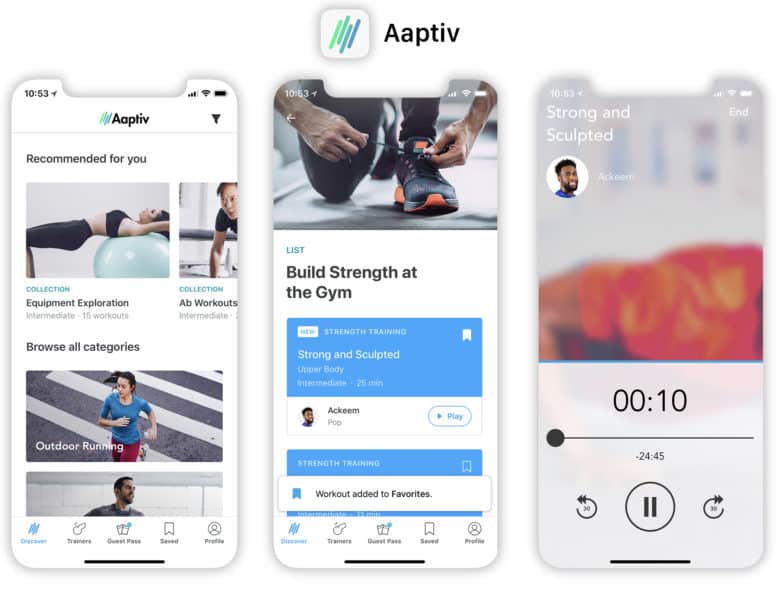
Aaptiv is a training app with a difference. Instead of providing how-to videos, it focuses on audio. A trainer talks you through your workout as you do it, combined with music. Different people have different learning styles. If you are more of an audio learner than a visual learner, this app could be for you.
At $14.99 per month, it’s not cheap, and there are no free workouts to try before you buy. But you can take advantage of a 30-day free trial. Just remember to cancel before the end of the trial if you decide you don’t want to subscribe. Otherwise, you could get charged $99.99 for a full year’s subscription.
There are more than 2,500 workouts, or “classes,” as Aaptiv calls them. As the term “classes” suggests, Aaptiv is more focused on cardio, but it does include strength training. The voice you hear during a class belongs to the personal trainer who designed it. And all the classes are organized by trainer, so you can get to know the ones you like.
There’s a companion Apple Watch app that lets you download the audio classes and listen to them without your iPhone. I found it takes a very long time to download workouts onto your watch, though, so remember to do this in advance.
